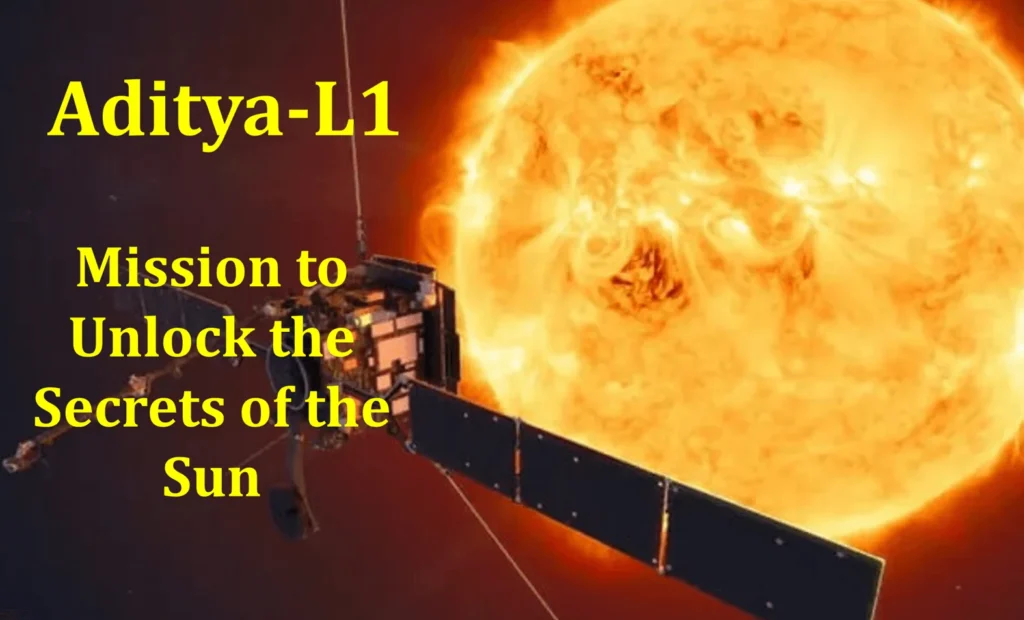
After the huge success of Chandrayaan-3, ISRO has launched its first solar mission. Now we can say that in our huge solar system, where all the planets and stars are constantly moving, there’s a special satellite called Aditya-L1. This satellite has been launched with the aim to send more information about the Sun which is our closest star. This mission is very interesting as it demonstrates the brilliance of scientist in India. The success of this mission will unlock the door of Sun’s mysteries. So, my dear reader let’s learn more about this Satellite named as Aditya L1.
Aditya-L1: A Glimpse into the Sun
“Aditya” is a word derived from Sanskrit, meaning none other than the Sun. And “L1”? It signifies Lagrange Point 1, an ethereal location in space where the gravitational tugs of two cosmic giants, our Sun and the Earth, harmoniously coexist. At this precise equilibrium, an object can remain in a stable embrace between these celestial entities, providing a front-row seat to the celestial spectacle that is our Sun.
Aditya-L1, like a patient observer, will stay in Earth-bound orbits for 16 days, gracefully undergoing five maneuvers to gain the velocity required for its grand voyage. Following this, the satellite embarks on a 110-day journey to the enigmatic L1 Lagrange point. Once there, another calculated maneuver locks Aditya-L1 into an orbit around L1, a region delicately balanced between our Earth and the fiery Sun.
ISRO’s Triumph: Aditya-L1 Takes Flight
On September 2, 2023, at 11:50 in the morning, ISRO, which is India’s space agency, launched the Aditya-L1 mission. The mission was launched from Satish Dhawan Space Cenre ,Sriharikota by PSLV-C57. This was a big moment for India’s space journey. The mission’s path is a bit like another famous one called Chandrayaan-3. First, it will be placed in the Earth’s orbit.
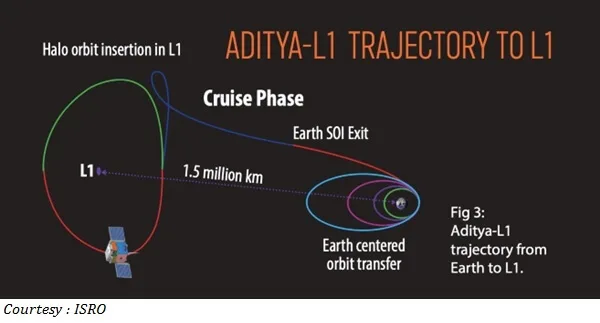
Here it will perform 5 maneuvers within 16 days to gain the necessary velocity to reach its destination i.e., the L1 point. The first Lagrange point (L1) between Earth and the Sun is located a staggering 15 lakh kilometers from our planet.
The Strategic Location L1
Now the question in your mind will be: What is this strategic Location L1? Let me answer it first. As mentioned earlier in this post, L1 Lagrange point is where the gravitational pull of earth and sun on an object is equal or say it is balanced. Placing Aditya-L1 at the L1 Lagrange point is a masterstroke of planning. It is a point from where any satellite gets an uninterrupted view of the sun for 24/7. Moreover, it grants Aditya-L1 access to solar radiation and magnetic storms before they’re swayed by Earth’s magnetic field and atmosphere. The gravitational stability at L1 reduces the need for frequent orbital adjustments, ensuring Aditya-L1’s operational efficiency.
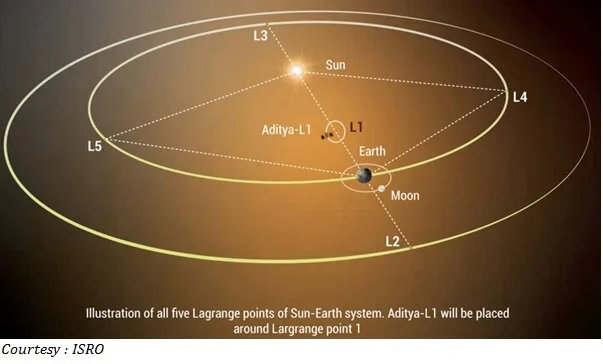
To put things into perspective, Aditya-L1 nestles approximately 1.5 million kilometers away from Earth, pointed sunward, which translates to just 1% of the Earth-Sun distance. The Sun, a colossal sphere of scorching gas, becomes the primary subject of study for Aditya-L1. Don’t be mistaken as this mission is not about landing on sun’s surface. It is only designed just to study the sun’s outer atmosphere.
Aditya L1 Payloads: Instruments of Revelation
Here’s the jewel in the crown: Aditya L1 is an entirely indigenous mission, conceived and executed by the Indian Institute of Astrophysics (IIA) in Bengaluru. In this mission, there are seven special tools that help us look at the Sun. They can see the Sun’s different parts like the photosphere, chromosphere and the outer layer called the corona. Four of these instruments are dedicated to scrutinizing the Sun, while the remaining three focus on the vicinity of the L-1 point.
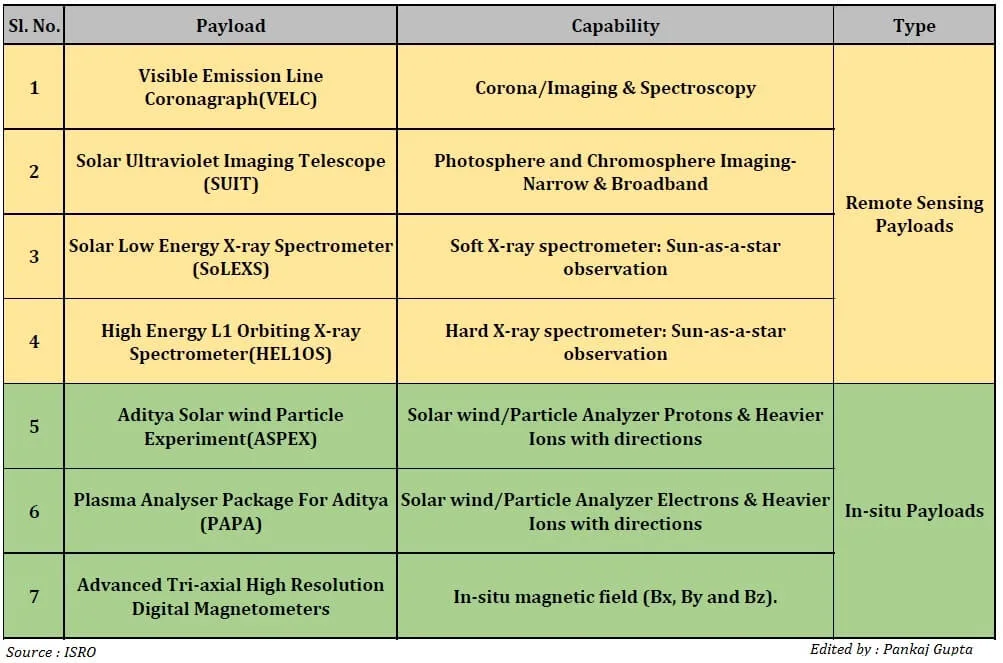
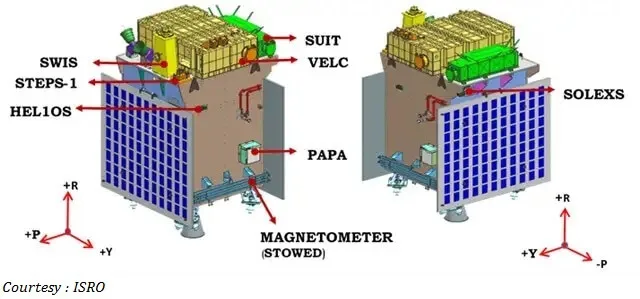
Scientific Marvels Await
The major objectives of Aditya L1 are as follows:
- Studying Solar Atmospheric Dynamics: Aditya L1 aims to study the dynamics of the Solar Atmosphere. The devices attached to Aditya L1 will try to study the chromospheric and coronal heating. It will be able to explain the changes in the Sun’s upper atmosphere, the chromosphere and the corona.
- Deciphering Solar Heating and Flares: The other major objective includes the study of the “solar flares”. Additionally, it will try to answer – How they are initiated and why they are important for solar activities.
- In-situ Particle and Plasma Studies: It will try to figure out the reason that makes the sun’s outer layer so hot and how special kinds of charged gas called “plasma” work.It will also elaborate plasma’s temperature, velocity and its density.
- Cracking the Coronal Heating Mystery: The instruments attached with the satellite will be able to give us information on the coronal and coronal loops.
- Solar Eruptive Events: Aditya L1 will try to explain big explosions on the Sun called “coronal mass ejections”. It will be identifying the sequence of processes occurring at multiple layers (chromosphere, base and extended corona) leading to solar eruptive events.
- Magnetic Field Insights: It will map the magnetic field topology and measurements in the solar corona.
- Space Weather Drivers: Uncovering the origins, composition and dynamics of the solar wind, the prime driver of space weather.
Wrapping it up
In essence, Aditya-L1 is humanity’s ticket to a deeper comprehension of our life-giving star. Earlier Chandrayaan-3 and now Aditya L1 have proved that how brilliant India and its scientist are in exploring the space. With the launching of Aditya L1 by PSLV-C57 the humanity has moved one step closer to understanding the space and the Sun. Moreover, in the grand cosmic tapestry, Aditya-L1 shines as a beacon of human curiosity and ingenuity. It will be guiding us towards the light of knowledge in the vast darkness of space. As the entire nation and the world waits for the discoveries to be made by Aditya L1. But one thing is certain: the Sun will never be the same again.

This is really informative, not many of us know about much about this project until this article, thanks to describe it in simple words.